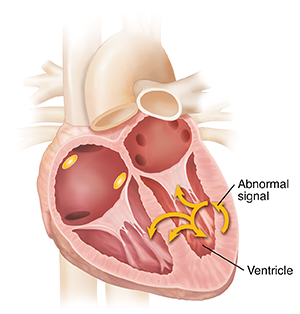Understanding Catecholaminergic Polymorphic Ventricular Tachycardia (CPVT) (Child)
Catecholaminergic polymorphic ventricular tachycardia (CPVT) is a type of problem with the heartbeat. It's a rare genetic condition. It causes a very serious, fast abnormal heart rhythm or irregular heartbeat (arrhythmia).
How to say it
CAT-uh-KOL-uh-min-ER-jick
polly-MOR-fick
ven-TRICK-yoo-ler
tack-i-CAR-dee-uh
What happens during CPVT?
A heartbeat usually starts in the upper right chamber of the heart. In people with CPVT, a sudden, fast heartbeat may start in the lower chambers of the heart. This causes an abnormally fast heart rhythm. This is called ventricular tachycardia. With CPVT, the heart beats so fast it doesn't have enough time to fill between beats. Less blood is pumped to the body and brain. This causes symptoms like dizziness, lightheadedness, heart beating harder or faster, or fainting. It may cause sudden cardiac death if it's not treated.

What causes CPVT?
CPVT is a genetic condition. It's caused by an abnormal change in a gene. This leads to electrical problems in the heart. It can be passed down through families. It may be inherited from 1 or both parents. But a child could be the first case in the family. There is a higher risk if there is a family history of fainting or sudden death.
If any family member has CPVT, all family members should have genetic tests and heart tests. These tests can find CPVT in other family members.
What are the symptoms of CPVT?
Symptoms of CPVT usually occur at a young age. But they may not happen until later in life. Your child may faint or almost faint. This happens most often during exercise or excitement. It can happen when feeling strong emotions. Your child may also have symptoms, such as:
The episode of ventricular tachycardia may go away on its own. Or it may turn into a very irregular and very fast heartbeat. This is a life-threatening heartbeat. It can cause the heart to stop. This is called cardiac arrest. It often leads to death. The person loses consciousness. They stop breathing. In some cases, CPVT with cardiac arrest may be the first time the condition is found.
How is CPVT diagnosed?
CPVT is often found at a young age. This usually happens when a child has fainted from physical or emotional stress. The healthcare provider will ask about your child’s health history and symptoms. They will ask about your family health history. Your child will have a physical exam. Your child may need to see a heart healthcare provider (cardiologist). They may suggest tests, such as:
-
Electrocardiography (ECG). This is to check your child’s heartbeat and rhythm. Resting ECG results are usually normal in people with CPVT.
-
Exercise stress testing. This is to check how the heart works when stressed, such as during exercise. It also looks at the heart rhythm during exercise.
-
Medicine challenge. A medicine is given that makes the heart work harder. This imitates exercise. This may be done if your child can’t exercise.
-
Event monitoring. Your child wears a portable ECG monitor for about 30 days. This device records heart activity.
-
Holter monitoring. Your child wears a portable ECG monitor for 1 or more days.
-
Echocardiography. This is an ultrasound of the heart. It's done to check for problems in the heart's structure and function. It shows problems in the heart's muscle, wall motion, and valves.
-
MRI of the heart. This test gives a more detailed view of the structures in and around the heart.
-
Heart catheterization. This test is done to study the physical and electrical function of the heart.
-
Genetic testing. This is to check for gene defects.
What is the treatment for CPVT?
CPVT is most often treated with medicines called beta blockers. These medicines help control the heart rhythm. Some children may need a cardioverter defibrillator. This is a small device put under the skin of the chest. It has wires that lead to the heart. The device can reset the heart rhythm when needed. Your healthcare provider will help you decide which treatment choices are best for your child.